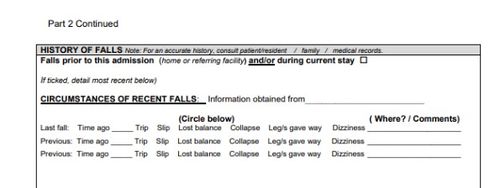Some Ideas on Dementia Fall Risk You Should Know
Some Ideas on Dementia Fall Risk You Should Know
Blog Article
Some Of Dementia Fall Risk
Table of ContentsThe 10-Minute Rule for Dementia Fall RiskDementia Fall Risk - QuestionsDementia Fall Risk Fundamentals ExplainedHow Dementia Fall Risk can Save You Time, Stress, and Money.6 Easy Facts About Dementia Fall Risk Shown
The FRAT has 3 areas: fall danger condition, risk factor checklist, and activity plan. A Loss Danger Status consists of information regarding history of current falls, drugs, emotional and cognitive standing of the individual - Dementia Fall Risk.If the patient ratings on a risk factor, the matching number of points are counted to the person's autumn danger score in package to the much ideal. If a client's fall threat rating totals 5 or greater, the individual goes to high risk for drops. If the person ratings just 4 factors or lower, they are still at some danger of dropping, and the registered nurse needs to utilize their best medical analysis to handle all autumn danger variables as component of a holistic care plan.
These typical approaches, in basic, help establish a safe environment that decreases unintended falls and marks core safety nets for all people. Indications are vital for individuals in jeopardy for falls. Health care service providers require to recognize who has the condition, for they are accountable for implementing actions to advertise patient security and protect against drops.
7 Easy Facts About Dementia Fall Risk Shown
For instance, wristbands ought to include the person's last and given name, day of birth, and NHS number in the UK. Details must be printed/written in black against a white history. Only red color ought to be utilized to signify special person condition. These suggestions are regular with present growths in patient recognition (Sevdalis et al., 2009).
Items that are too much might call for the patient to connect or ambulate needlessly and can potentially be a threat or contribute to drops. Aids protect against the client from going out of bed without any kind of aid. Nurses reply to fallers' phone call lights a lot more swiftly than they do to lights launched by non-fallers.
Aesthetic problems can greatly cause drops. Hip pads, when used appropriately, might reduce a hip fracture when fall occurs. Keeping the beds closer to the floor reduces the danger of drops and major injury. Putting the cushion on the floor considerably reduces autumn risk in some medical care setups. Reduced beds are developed to minimize the range an individual falls after moving out of bed.
How Dementia Fall Risk can Save You Time, Stress, and Money.
Patients who are high and with weak leg muscle mass that try to rest on the bed from a standing placement are most likely to fall onto the bed because it's also reduced for them to reduce themselves securely. Likewise, if a tall client attempts to get up from a reduced bed without aid, the individual is most likely to fall back down onto the bed or miss the bed and fall onto the floor.
They're created to advertise prompt rescue, not to avoid falls from bed. Audible alarm systems can likewise advise the individual not to stand up alone. The use of alarms can likewise be a replacement for physical restraints. Besides bed alarm systems, increased supervision for risky patients also may aid prevent falls.

Patients with an evasion gait increase loss opportunities significantly. To minimize autumn danger, footwear must be with a little more helpful hints to no heel, slim soles with slip-resistant step, and sustain the ankle joints. Advise client to utilize nonskid socks to prevent the feet from gliding upon standing. Encourage patients to use proper, well-fitting shoesnot nonskid socks for motion.
Rumored Buzz on Dementia Fall Risk
People, specifically older adults, have decreased visual capacity. Lighting a strange atmosphere aids enhance exposure if the patient must obtain up in the evening. In a study, homes with ample lights record fewer falls (Ramulu et al., 2021). Enhancement in illumination in your home may reduce loss prices in older grownups (Dementia Fall Risk). Making use of stride belts by all wellness care service providers can promote security when aiding clients with transfers from bed to chair.

Sitters work for guaranteeing a safe, safeguarded, and safe atmosphere. However, research studies showed extremely low-certainty evidence that caretakers lower autumn threat in severe care hospitals and only moderate-certainty that choices like video monitoring can decrease caretaker usage without increasing autumn risk, recommending that caretakers are not as useful as initially believed (Greely et al., 2020).
The Buzz on Dementia Fall Risk

Raised physical conditioning decreases the threat for drops and restricts injury that is pop over to this web-site received when fall takes place. Land and water-based exercise programs may be in a similar way advantageous on balance and stride and consequently lower the threat for drops. Water workout may contribute a positive benefit on balance and stride for ladies 65 years and older.
Chair Surge Workout is a simple sit-to-stand workout that helps strengthen the muscle mass in the upper legs and buttocks and improves movement and independence. The goal is to do Chair Rise workouts without utilizing hands as the customer comes to be more powerful. See sources section for an in-depth direction on exactly how to execute Chair Surge exercise.
Report this page